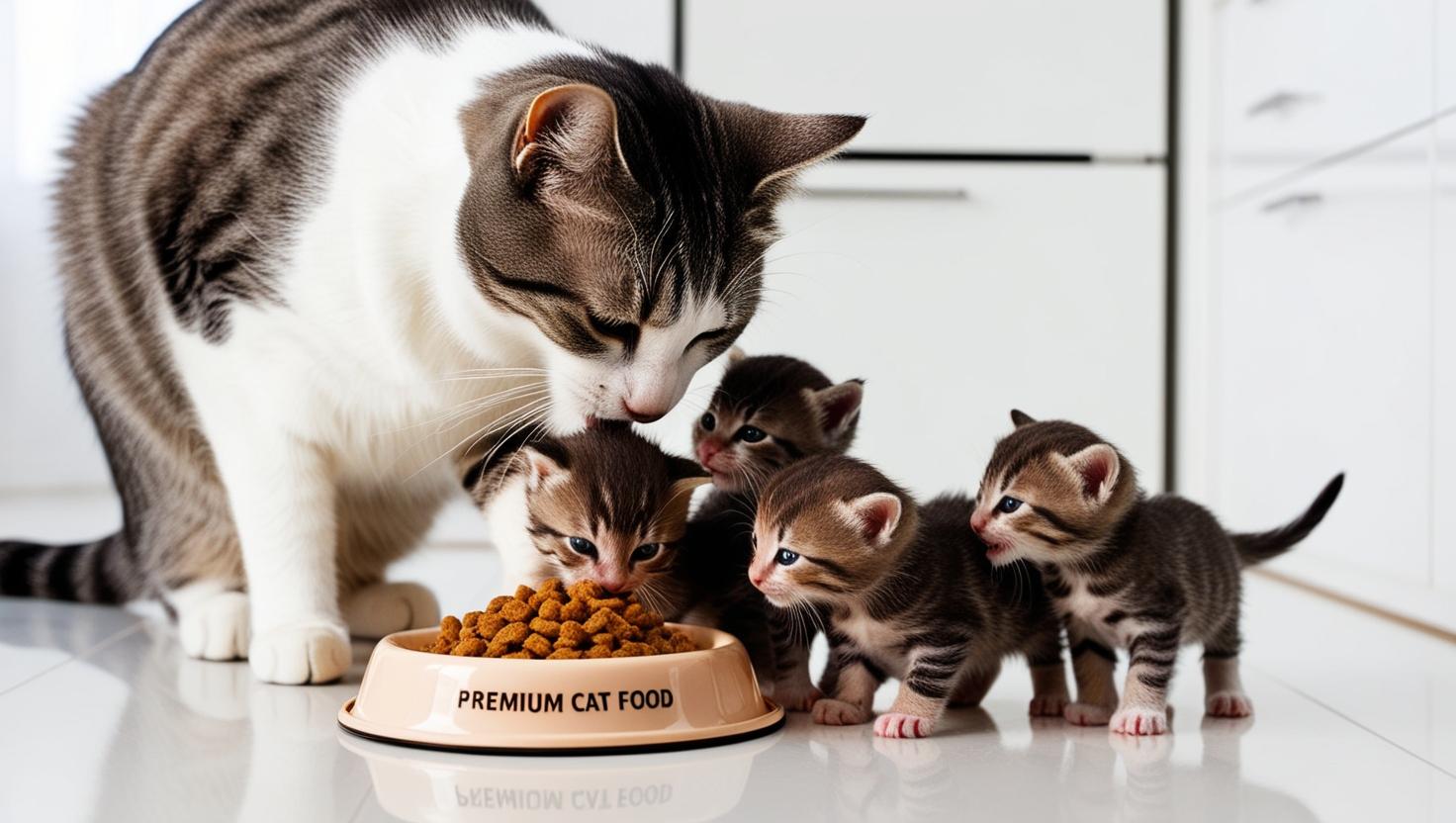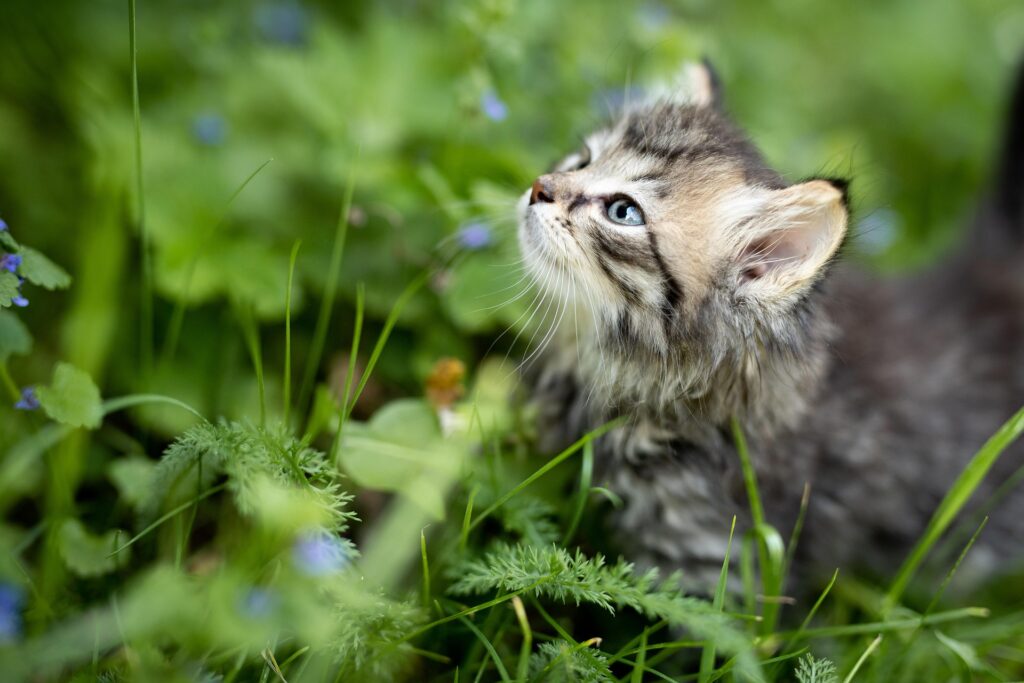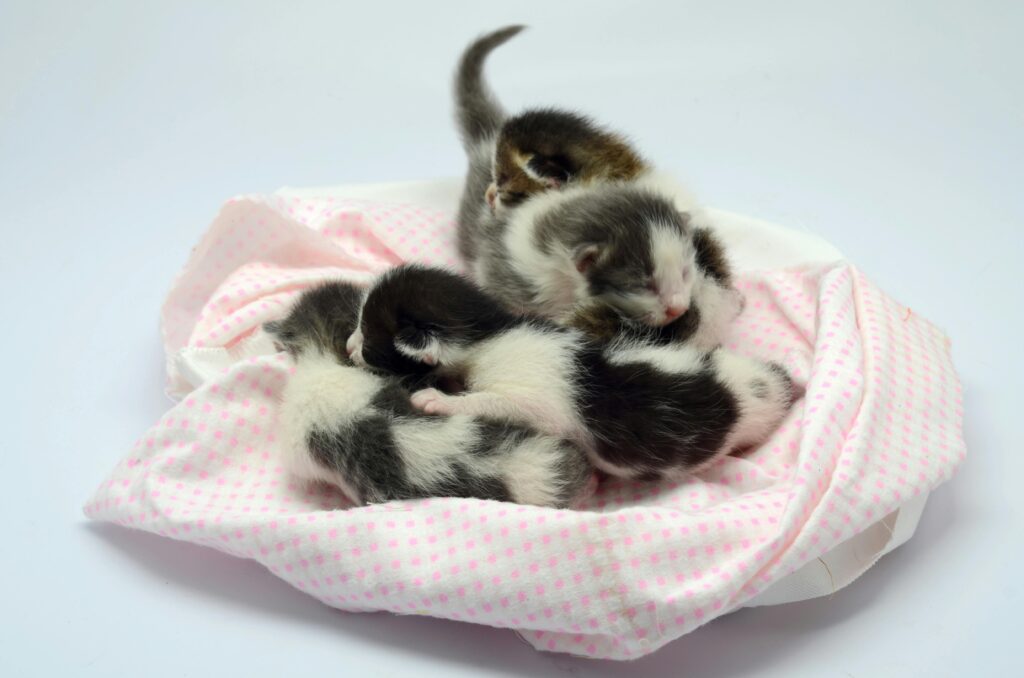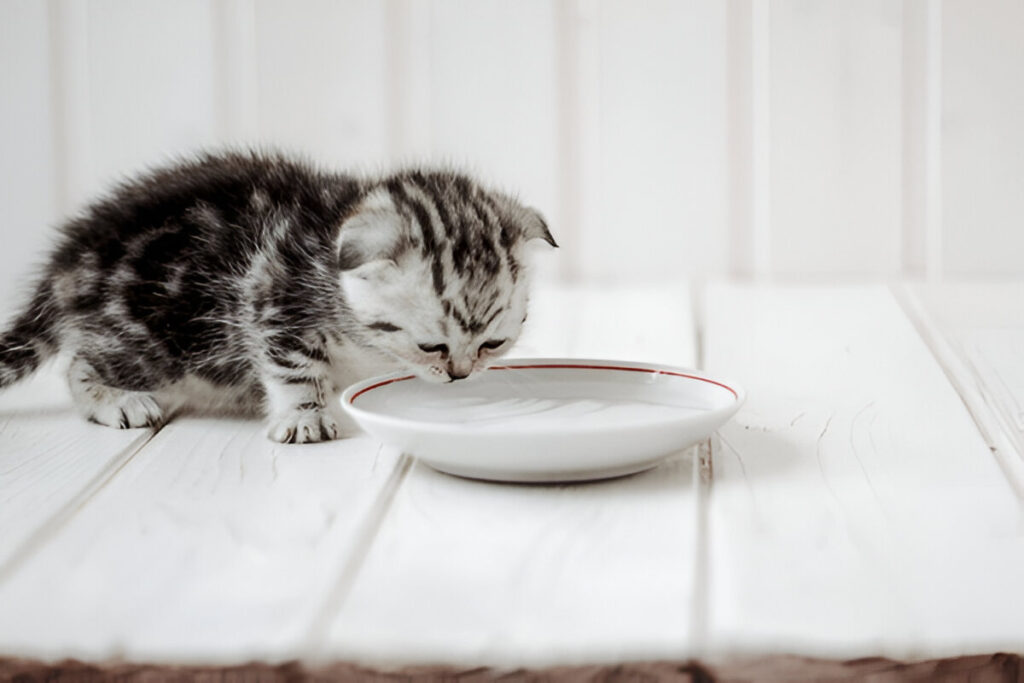Can Kittens Eat Adult Cat Food?
As a pet owner, ensuring your kitten has the proper nutrition is critical to their growth and development. One common question is whether kittens can eat adult cat food. Understanding the differences in nutritional requirements between kittens and adult cats is essential for making informed dietary choices for your furry friend.
The Nutritional Differences Between Kitten and Adult Cat Food
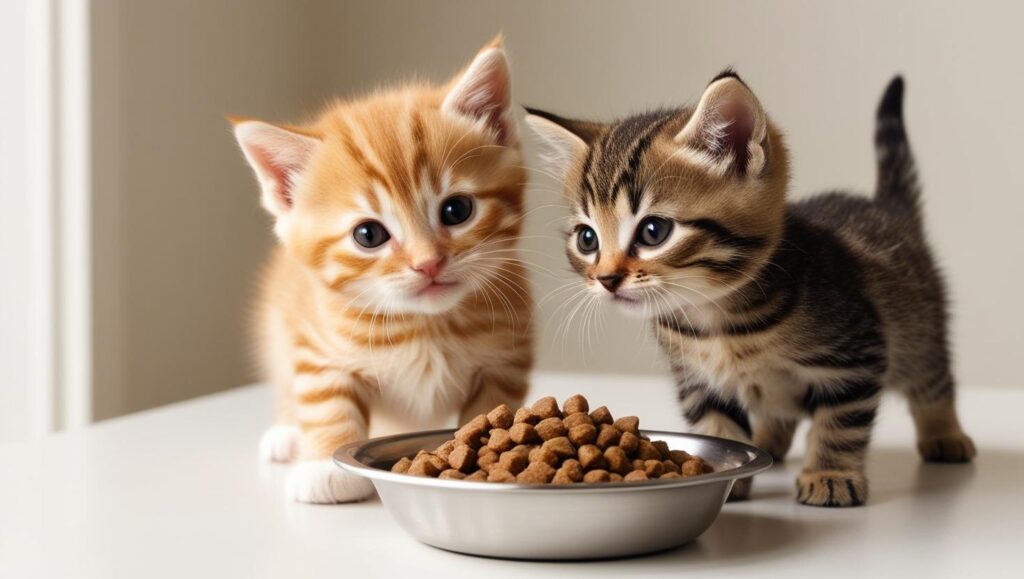
Kitten foods and adult cat foods are formulated based on the nutritional needs of the particular life stage. Feeding the right food to your pet at the proper time in their lives is very important to health and development. The key differences are listed below.
Kitten Food
Kitten food is formulated to meet the rapid growth and development occurring in the first year of a kitten’s life. This is a period of high energy demand, development of vital body systems, and laying the foundation for lifelong health.
- 1. Higher Protein Content:
Kitten’s requirement for protein is much higher than that of an adult cat. It is indispensable in the formation and repair of tissues, besides supporting rapid growth and development of muscles and organs. Kitten food is a specific formulation that is adequately balanced with amino acids for supporting the growth needs.
- Increased Levels of Fat:
Being a dense source of energy, the fat content of kitten food helps meet their extra calorie needs while being very active; kittens require more calories per pound of body weight compared with adult cats. This high proportion of fat supports the absorption of fat-soluble vitamins. - Essential Growth Nutrients:
Ingredients such as DHA, an omega-3 fatty acid derived from fish oil, are very important for brain and retinal development for sharp vision and intellect. Calcium and phosphorus are added in larger quantities for building strong bones and teeth.
Adult Cat Food
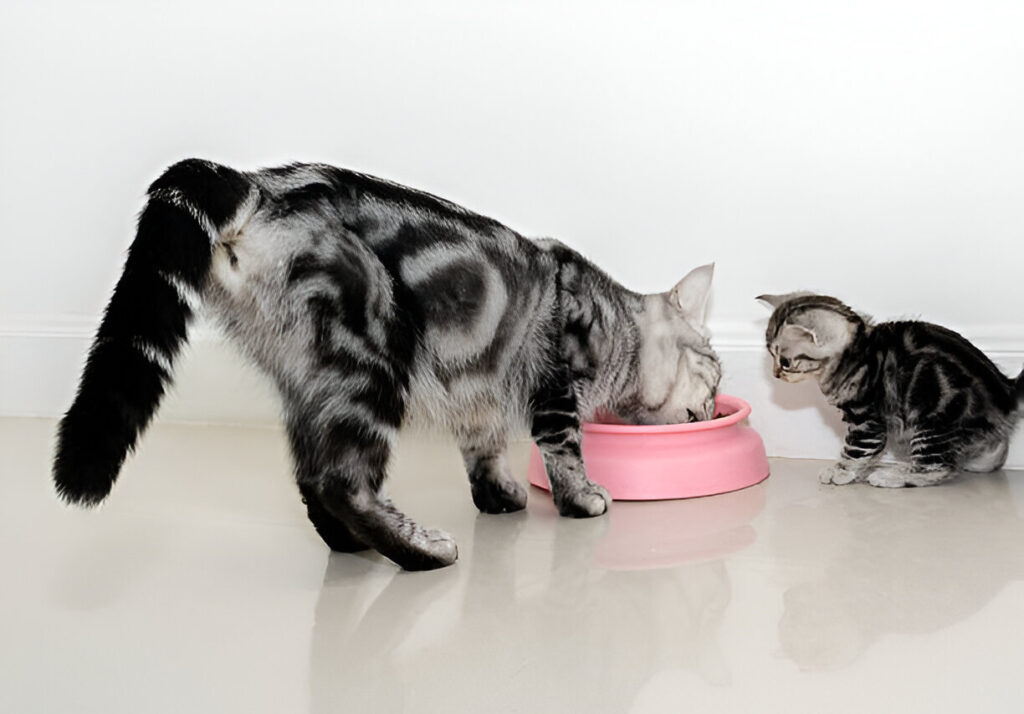
As cats reach maturity, the growth rate slows down, and their needs shift toward the maintenance of overall health and prevention of obesity. Adult cat foods are formulated with these needs in mind:
- Moderate Levels of Protein:
While protein is essential, adults do not need as much as kittens since the latter are in a high growth phase. Too much protein can put an extra load on the kidneys of older cats, so it needs to be given in moderation. - Balanced Fat Content:
Adult cat food is manufactured with a reduction in the fat level compared to kitten foods to reflect their lowered energy needs. This will avert obesity while still maintaining adequate energy for daily activities. - Maintenance Nutrients:
Adult cat food is formulated for the maintenance of muscular strength, immune health, and overall wellness. All nutrients, vitamins, minerals, and antioxidants are provided in the correct amounts a mature cat requires.
Why Feeding Life Stage-Appropriate Food is Important
Feeding adult cat food to kittens can result in:
- Nutritional Deficiencies: Without appropriate protein, fats, and growth-specific nutrients, kittens will not reach their full developmental potential.
- Poor Growth: Insufficient caloric and nutrient intake can lead to stunted growth, weak bones, and underdeveloped muscles.
Similarly, feeding adult cats kitten food may cause:
- Additional Calories: Increased fat and calorie content may lead to extra weight gain on an adult cat. – Poor Nutrient Balance: Adult cats will intake some nutrients that exceed their requirements, which could have unhealthy implications in the long run.
Why Feeding Kittens Adult Cat Food Can Be Problematic
While it might seem convenient or cost-effective to do so, feeding kittens adult cat food can create a number of health and developmental issues. Kittens require different nutrition from adult cats, and not providing them with the nutrition they need can affect them their entire lives. Here is a list of major reasons why kittens should not be fed adult cat food:
1. Lack of Proper Nutrition
The kitten is in the very critical growth phase, hence the higher amount of proteins, fats, and other components in kitten food, as compared to adult cat food formulated just for sustaining a grown-up feline.
- Lack of Protein: Protein forms the building block for muscles, organs, and tissues. Adult cat food has a lower amount of protein compared to what kittens actually need, hence this may slow proper growth and muscle development.
- Insufficient Fat: Fat is a form of nutritionally dense energy source for kittens, who have higher energy demands compared to adults. Kittens may fail to meet their basic needs if the fat content in adult foods is lower.
- Missing Growth Nutrients: Kitten food contains many nutrients including DHA, required for growth of the brain and vision; calcium and phosphorus are particularly important in their roles of keeping bones and teeth healthy.
Adult food does not have any of these in enough amount to be given to a growing cat or kitten.
2. Possible Health Problems
Feeding the adult cat food to your kitten may result in nutritional deficiency and affect its overall health:
- Stunted Growth: Kittens that do not get enough nutrients will not grow to their full potential, which may affect their size and musculature.
- Weakened Immune System: Kittens need more nutrients for the proper building of their immune system. A lack of such nutrients may leave them at a high risk of infection and diseases.
- Developmental Problems: Poor levels of DHA lead to suboptimum development of the brain and retina, which potentially affects cognitive functions and vision. Similarly, poor calcium and phosphorus lead to bones that are either weak or fragile, where fractures are common.
3. Nutrient Imbalance
Kittens have unique nutritional needs that involve much more than just the correct nutrient profile; their high-energy lifestyle and rapid growth also require a unique approach to calories and nutrient balance.
- Insufficient Calorie Density: Kittens are very active and require more calories per pound of body weight compared to adult cats. The low calorie density in the food for adult cats may not sufficiently provide enough energy, thus leaving kittens with fatigue or underweight.
- Nutrient ratio mismatch: Adult cat foods have nutritional compositions matching the need of the adult for merely sustaining the cat’s health without growth. Such an approach leads to developmental abnormalities and possibly other adverse complications.
When is it Safe to Transition a Kitten to Adult Cat Food?
Kittens can generally be transitioned to adult cat food when they reach about 12 months of age. However, this timeline can vary based on breed and individual growth rates. Signs your kitten may be ready for adult food include:
- Slowed Growth: As your kitten’s growth rate decreases, their nutritional needs change.
- Behavioral Changes: Adult cats are typically less energetic than kittens, necessitating a shift in calorie intake.
- Veterinarian’s Recommendation: Always consult with your vet to determine the best time to make the transition.
What to Look For in Quality Kitten Food
Choosing high-quality kitten food is vital for your pet’s health. Look for products with:
- High Protein Content: Aim for foods with meat or fish as the primary ingredient.
- Essential Vitamins and Minerals: Nutrients like vitamin E, taurine, and DHA are crucial for development.
- No Harmful Additives: Avoid foods with excessive fillers, artificial colors, or preservatives.
- Reputable Brands: Established pet food brands often have rigorous quality control and balanced formulations.
Tips for Gradually Introducing New Foods to Your Kitten’s Diet
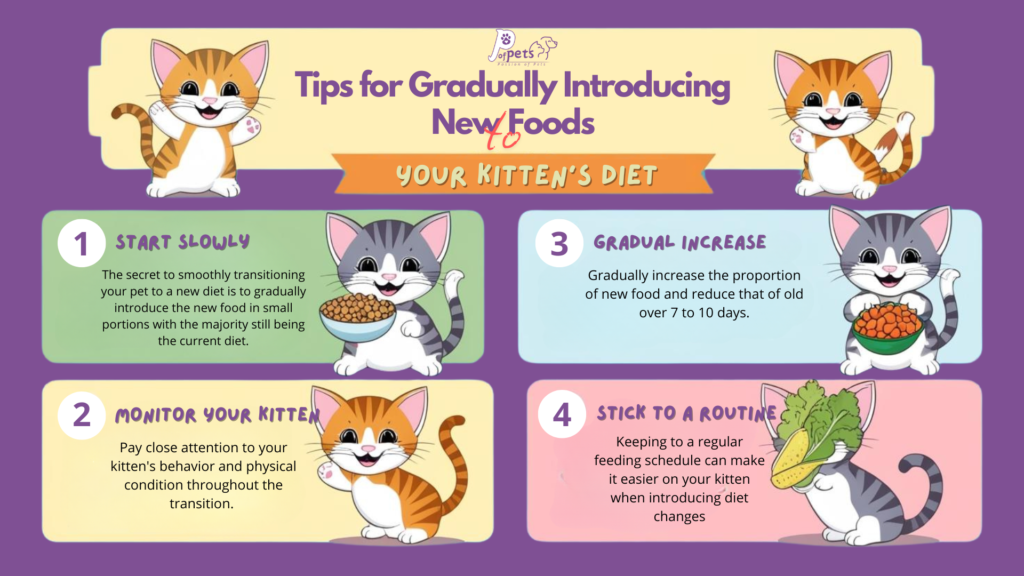
You may need to switch your kitten’s food for any number of reasons, from transitioning a kitten to adult food, because of dietary needs, or even just to switch to a better quality food. However, upsets can easily occur due to their sensitive digestive systems. You can transition smoothly through a few easy, gradual steps.
Start Slowly
The secret to smoothly transitioning your pet to a new diet is to gradually introduce the new food in small portions with the majority still being the current diet.
- Gradually mix approximately 25% of the new food with 75% of the current food.
- This ensures that your kitten’s digestive system isn’t overwhelmed with new ingredients that it’s probably not used to.
Gradual Increase
Gradually increase the proportion of new food and reduce that of old over 7 to 10 days.
- By days 3 to 4, it should already be a mixture of 50/50 new and current.
- Till days 5 to 6, it would be time for about 75%, new food against 25%, old food.
- Till day 7 – 10 your kitten should just be on the new food.
This gradual process minimizes the risk of gastrointestinal upset, such as diarrhea, constipation, or vomiting.
Monitor Your Kitten
Pay close attention to your kitten’s behavior and physical condition throughout the transition.
- Signs to Watch For: Loose stools, vomiting, decreased appetite, lethargy, or any changes in energy levels.
- If you notice any adverse reactions, either go slower with the changeover or consult your veterinarian for an opinion.
Stick to a Routine
Keeping to a regular feeding schedule can make it easier on your kitten when introducing diet changes.
- You should feed your kitten at the same time every day to establish a routine.
This helps their digestion be properly regulated and does not create added stress from a change in nutrition.
Choose the Appropriate Food
Ensure that the new food chosen is appropriate for the lifestage, breed, and special health concerns of the kitten.
High-quality kitten food with complete and balanced nutrition should be selected.
- Consult your veterinarian for suggestions, especially if your kitten has dietary restrictions or health conditions.
Leave Fresh Water Available
Your kitten will want more water during the adjustment period, especially if the new food has less moisture in it, such as switching from wet food to dry food. Always have clean, fresh water available to help digest and maintain hydration.
Be Patience
Obviously, not all kittens will be identical, and the time it takes for them to get used to new food may vary. Never rush the process; also, when it takes more time, it shouldn’t discourage you. Gradual is always better than sudden.
The Benefits of Consulting a Veterinarian About Your Kitten’s Diet
| Step | Details | Key Notes |
|---|---|---|
| 1. Start Slowly | Begin by mixing 25% of the new food with 75% of the current food. Gradually introduce the new food in small portions while retaining the majority of the current diet. | – Prevents overwhelming the kitten’s digestive system. – Allows the stomach to adjust to new ingredients. |
| 2. Gradual Increase | Over 7–10 days, steadily increase the proportion of the new food while decreasing the current food. | – Days 1–2: 25% new food, 75% current food. – Days 3–4: 50% new food, 50% current food. – Days 5–6: 75% new food, 25% current food. – Day 7–10: 100% new food. |
| This slow transition minimizes the risk of digestive upset, such as diarrhea, vomiting, or constipation. | – Be flexible and extend the timeline if necessary to avoid stressing your kitten. | |
| 3. Monitor Your Kitten | Keep a close watch on your kitten’s health and behavior throughout the process. | – Signs of Concern: Loose stools, vomiting, lethargy, decreased appetite, or changes in energy levels. – Adjust the pace or consult a vet if issues arise. |
| Monitoring ensures that your kitten’s body is adapting well to the dietary change. | – Small deviations in appetite or stool consistency can be normal, but significant changes warrant intervention. | |
| 4. Stick to a Routine | Feed your kitten at the same times daily. Consistent timing regulates digestion and minimizes stress during diet transitions. | – Routine feeding creates a sense of predictability. – Avoid skipping meals or sudden feeding schedule changes during the transition period. |
| 5. Choose Appropriate Food | Ensure the new food is tailored to your kitten’s age, breed, and any special health requirements. | – Opt for high-quality food labeled for kittens with complete and balanced nutrition. – Consult your vet if your kitten has allergies or dietary restrictions. |
| Look for foods enriched with essential nutrients such as DHA, calcium, and phosphorus to support growth and development. | – Avoid foods with excessive fillers or artificial additives that may not be suitable for kittens. | |
| 6. Leave Fresh Water Available | Provide clean, fresh water at all times, especially if switching from wet to dry food. | – Increased water intake is crucial for digestion and hydration. – Use a shallow bowl or pet fountain to encourage hydration. |
| Proper hydration supports healthy kidney function and overall well-being during the transition. | – Replace water daily and clean the bowl regularly to avoid contamination. | |
| 7. Be Patient | Recognize that every kitten adapts differently. Some may take longer to adjust to new food than others. | – Don’t rush the process, even if it takes more time than expected. – Gradual change ensures better acceptance and minimizes health risks. |
| Patience and consistency are key to a smooth transition. | – Stay observant and make adjustments as needed to support your kitten’s unique needs. |
Conclusion:
Ensuring Your Kitten Grows Up Healthy and Strong with the Right Nutrition
Providing your kitten with the right food is one of the most important steps in raising a healthy and happy cat. By understanding their unique nutritional needs, choosing high-quality kitten food, and transitioning to adult food at the appropriate time, you set the foundation for a lifetime of well-being. Don’t hesitate to seek professional advice to ensure your furry friend’s dietary needs are met at every stage of their life.
Yuns Legdm is a passionate advocate for pet care and the founder of this website, dedicated to providing valuable information for fellow pet lovers and veterinary professionals worldwide. With a deep love for animals, Yuns created this platform to connect passionate pet owners with expert insights from veterinarians around the globe.
This website grows with you—the passionate pet owners and veterinary experts—creating a trusted space where knowledge, experience, and love for animals come together. Whether you’re seeking advice on pet health, nutrition, or general well-being, this platform is here to support you on your journey of responsible and loving pet care.

